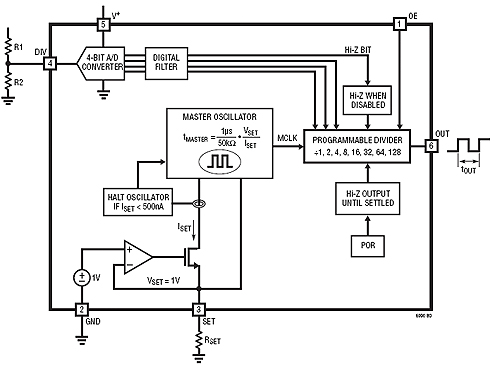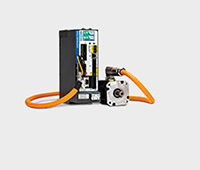By Chris Francis
I have used various programmable clock generator chips, such as the PLL based devices from IDT for generating high frequency clocks in mixed signal systems, such as pixel clocks for analog to digital converters in video systems. In those applications precision frequencies can be important and speed can be more than 100MHz. The “TimerBlox” (not a great name!) from Linear Technology are aimed at different, lower frequency, lower accuracy applications. They are more like increased range/functionality 555 timers. The devices are the LTC6990 to the LTC6695 with various versions of some e.g. the LTC6992 has 4 versions, the LTC6992-1 to the LTC6992-4. The achieve this additional range by including programmable dividers.
In general the TimerBlox are low frequency devices – the fastest being 2MHz output with the lowest frequency being 9½ hours between pulses. They are low power, down to 55µA, but not ultra-low power, and of reasonably accuracy, 0.8% to 2.4%. So, they aren’t for generating precision timing but good enough for many applications. They could be used where in the past you might have used a small internal microcontroller to provide either timing or a delay, relying on the internal microcontroller clock which is typically 2% depending on the device. However, that requires a bit more work writing some of software.
Depending on the device, the TimerBlox are either:
- voltage controlled oscillator (VCO)
- low frequency oscillator
- pulse width modulator (PWM)
- monostable.
The LTC6990 is a VCO generating 488Hz to 2MHz. A 4 bit internal analog to digital converter (ADC) is used to allow a divider to be programmed with a single pin and two resistors. This is a similar programming system seen on some other ICs such as iC-Haus programmable interpolators. An external resistor in combination with the divider sets the frequency on the LTC6990, with the divider covering a dividing range of 1 to 128. The frequency can be voltage controlled by adding an extra resistor to the frequency setting resistor, connected to the control voltage.

The LTC6991 is more like a low frequency 555 in astable mode, with a period of 1ms to 9.5 hours. It achieves this by including a divider but in this case dividing from 1 to 2,097,152.
The LTC6992 is a PWM chip controlled by a 0-1V analog signal. The frequency range is 3.8Hz to 1MHz with 0-100% duty cycle range for the -1 version, with alternative versions -2, -3 and -4 limiting the duty cycle to 5% and/or 95%. Again, a programmable divider and resistor combination set the frequency. It is like the LTC6990 but with a PWM input and wider range (due to a larger divider). It can also be frequency modulated.
The LTC6993 is a monostable with a 1us to 33 second range. A wide range divider (like the LTC6991) makes the wide pulse range possible. The pulse width can be voltage controlled by applying a voltage to the pulse width resistor through another resistor – pretty much the same way the VCO is implemented in the LTC6990/6992. The -1/2/3/4 variants determine if the monostable is rising or falling edge triggered and whether it is retriggerable or not.
The LTC6994 is similar to the LTC6993 but is a delay block, delaying either one or both edges of the input pulse by 1us to 33 seconds. The -1 and -2 variants allow you to decide whether you delay only the rising all falling edge (the -1 version) or both edges (the -2 version). The -2 also allows the pulse to be inverted.
Finally, the LTC6995 is a long timer/low frequency oscillator with 1ms to 9.5 hour range (similar to the LTC6990 range). Variants allow the reset input to be active high or low.
All devices are only 6 pin packages (DFN or TSO23) which is partly why there are the additional -1/-2 variants to add functions which could easily have been included in the basic chip with an extra pin. Presumably the functions are actually all in the base chip but set by a bonding option during packaging.
So, an interesting range of devices which could have many uses. My main concern would be price. Typically they cost from $1.80 to over $5 depending on the package and temperature range. With a simple PIC12 microcontroller typically under $1 and PIC10 devices less than half that, there are cheaper solutions, but you would have to put in some programming effort to get a working solution. Also, at the shorter pulse widths/times you may get some jitter in a software based solution. For battery applications the current consumption of the LTC699x range could be a problem; 55µA is not that low considering microcontrollers have watchdog timers below 1µA although admittedly with very poor precision.
Filed Under: MOTION CONTROL





Tell Us What You Think!